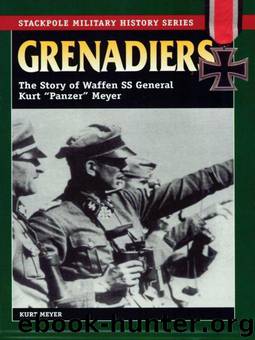Grenadiers: The Story Of Waffen SS General Kurt 'Panzer' Meyer (Stackpole Military History) by Meyer Kurt

Author:Meyer, Kurt [Meyer, Kurt]
Language: eng
Format: epub, mobi
Publisher: Stackpole Books
Published: 2005-06-01T07:00:00+00:00
I had already been told at the outset of the invasion that the Allies did not take the Geneva Convention very seriously and the divisions that had already landed had taken few prisoners. On the morning of 9 June I found a group of German soldiers on the railway line south of Rots. They had obviously not been killed in action as they were all laying next to the road and all had been shot through the head. They were soldiers from the 21. Panzer-Division and the staff of the 12. SS-Pan-r.er-Division “Hitlerjugend”. The incident was immediately reported to the division which, in turn, passed it back to corps.
The regimental commander of Panzer-Artillerie-Regiment 130 (Panzer-Lehr-Division) became a British prisoner of war together with a battalion commander, Major Zeiβler, Hauptmann Graf Clary-Aldringen, and about six noncommissioned officers and enlisted men on the morning of 8 June. They had been captured by armor from the British “Inns of Court” Regiment, which had penetrated behind the German lines.
After the German officers had refused to voluntarily act as human shields, the badly injured Oberst Luxemburger was fettered by two British officers, beaten unconscious and, in that blood-covered condition, tied to a British tank as a shield. After receiving orders from their superiors, the British tanks fired on Major Zeiβler, Hauptimann Graf Clary-Aldringen and the other soldiers as they moved off.
Hauptmann Graf Clary was found bv members of SS-Batitillon Siebken and brought to the battalion command post. The British tank on which Oberst Luxemburger had been tied as a shield was hit by a German antitank gun; he died two days later in a military hospital. Hauptmann Graf Clary received first aid from SS-Sanitäter Klöden.
On 7 June, a notebook was found on a Canadian captain with notes about the orders given before the invasion. Besides the tactical instructions, there were also instructions on how to fight. It read: “No prisoners are to be taken.” The notebook was given to the Commander-in-Chief of the 7. Armee, Generaloberst Dollmann, by the Operations Officer of the 12. SS-Panzer-Division on 8 June. The officers and men of the Canadian 3rd Division, who had been interrogated by the 12. SS-Panzer-Division, confirmed they had received orders from their superiors not to take any prisoners. A soldier stated that they were not supposed to take prisoners if they were hindering operations.
During Bernhard Siebken’s war crimes trial in November 1948, Oberst i.G. Meyer-Detering, the Intelligence Officer to the Commander-in-Chief West, Feldmarschall von Rundstedt, stated: “Right at the onset of the invasion, I twice received documents captured in the Canadians Army sector on the eastern flank of the invasion front which showed that no prisoners were to be taken.”
At the same trial Oberstleutnant i.G. von Zastrow, who was the intelligence officer to the Commanding General of Panzergruppe West, General Geyr von Schweppenburg, stated that he obtained information at that time of crimes committed by Allied troops in violation of the Hague Declaration on Land Warfare and of the Geneva Convention. He then told about
Download
Grenadiers: The Story Of Waffen SS General Kurt 'Panzer' Meyer (Stackpole Military History) by Meyer Kurt.mobi
This site does not store any files on its server. We only index and link to content provided by other sites. Please contact the content providers to delete copyright contents if any and email us, we'll remove relevant links or contents immediately.
| Civil War | Operation Desert Storm |
| Veterans | Vietnam War |
The Radium Girls by Kate Moore(10959)
The Templars by Dan Jones(4218)
100 Deadly Skills by Clint Emerson(4119)
Rise and Kill First by Ronen Bergman(4059)
The Doomsday Machine by Daniel Ellsberg(3767)
The Rape of Nanking by Iris Chang(3562)
Killing England by Bill O'Reilly(3486)
Hitler in Los Angeles by Steven J. Ross(3470)
Stalin by Stephen Kotkin(3114)
12 Strong by Doug Stanton(3077)
Hitler's Monsters by Eric Kurlander(2758)
Darkest Hour by Anthony McCarten(2671)
Blood and Sand by Alex Von Tunzelmann(2630)
The Art of War Visualized by Jessica Hagy(2440)
Hitler's Flying Saucers: A Guide to German Flying Discs of the Second World War by Stevens Henry(2320)
The Code Book by Simon Singh(2245)
The Second World Wars by Victor Davis Hanson(2149)
Babylon's Ark by Lawrence Anthony(2092)
Tobruk by Peter Fitzsimons(2078)
